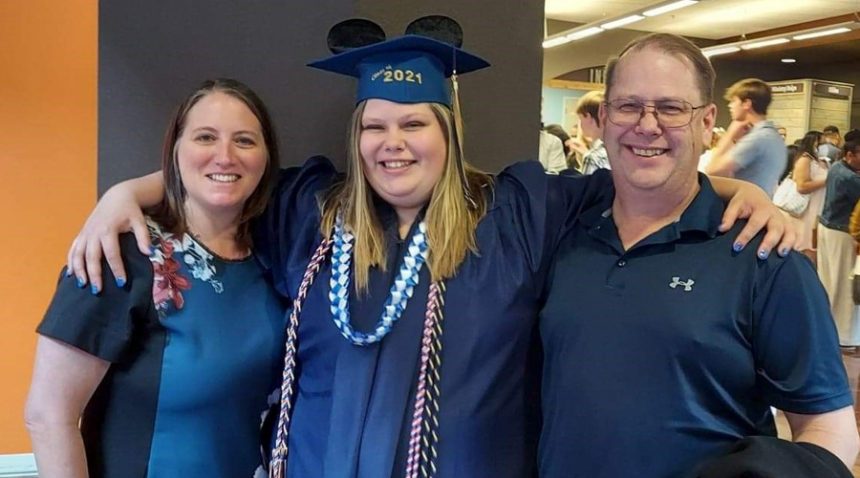When Kathy Landers left her hometown of Colorado Springs to visit Raleigh for her daughter’s archery tournament in 2019, she didn’t know an emergency surgery would be a part of the trip.
She ended up suffering a stroke at the hotel—something she never expected to happen at the age of 45.
Her husband recognized the signs quickly: Her face was drooping, she was stumbling and she couldn’t speak. She was rushed to the hospital, where a quick intervention by Tibor Becske, MD, a UNC Health neurointerventionalist, saved her life.
Dr. Becske breaks down how to recognize the signs of a stroke and why immediate treatment is crucial for recovery.
Know What Raises Your Risk of a Blood Clot
A stroke occurs when the brain stops receiving oxygen, either because of a blockage in blood flow (ischemic stroke) or a burst blood vessel (hemorrhagic stroke). Ischemic strokes are the most common, and there are two main types: atherothrombotic, when a blood clot develops at the site of cholesterol buildup in the brain’s blood vessels, and embolic, when a clot develops outside the brain and travels to one of the blood vessels in the brain.
Landers suffered an embolic stroke, which happens fast and typically without warning. Anyone can have a stroke, but Dr. Becske says there are a few things that can increase a person’s risk of developing a life-threatening clot, including irregular heartbeat (atrial fibrillation), pregnancy, the use of hormonal treatments, a family history of blood clots or heart disease, high blood pressure, or an unhealthy lifestyle (smoking, a bad diet or lack of exercise).
If you are at an increased risk of blood clots, talk to your doctor about getting bloodwork done to see if taking regular blood thinners might be right for you.
Time Is Brain: Quick Intervention After Stroke Is Key
Thankfully, Landers was rushed to UNC Rex Hospital as soon as she started showing stroke symptoms. Dr. Becske performed a thrombectomy, where a catheter is threaded up to the blockage and a small device is inserted to remove the clot blocking blood flow to the brain.
It only takes about four minutes for brain cells that are completely deprived of oxygen to die, Dr. Becske says. Fortunately, the brain vessels have connections that allow for a longer window to intervene. Quick treatment, within the first few hours of symptom onset, helps improve chances of survival and minimize brain damage.
After the procedure, Landers experienced immediate improvement. However, she suffered from residual right-sided weakness and severe aphasia, a language disorder that occurs when the part of the brain that controls communication is injured.
“I could think, but my mouth was broken. I felt like I had a toddler trapped in my body because I couldn’t express what I needed,” Landers says. “It was really hard and frustrating.”
For weeks, she was stuck using only a few phrases and communicating with a whiteboard. However, after a year of hard work, therapy and faith, she made a full recovery. She even met her goal of being able to see her daughter compete in an archery tournament again.
“Dr. Becske is my miracle worker,” Landers says.
He attributes Landers’ success to how quickly she was rushed to the hospital and the improvements in stroke treatment that have been made in recent years.
“Twenty years ago, Kathy may not have had such a great outcome,” Dr. Becske says. “The technological development of imaging and devices has helped us be able to more consistently open up the blood vessels. The biggest question is usually if the patient was able to make it to surgery early enough for the procedure to be meaningful, and in Kathy’s case, it was.”
Landers Helps Other Stroke Survivors
Now Landers has become a hospital volunteer in Colorado Springs to help other stroke survivors through the recovery process.
“My physical therapist at UNC Rex was my lighthouse in the storm, and now I want to pay it forward,” Landers says. “I want other stroke survivors to know: ‘You are valuable and you are important. Never give up and keep going.’”
On the three-year anniversary of her stroke, Landers flew back to Raleigh to thank her care team.
“I just wanted them to remember the ‘after’ and not the ‘before,’” Landers says.
Dr. Becske calls her story an inspiration.
“Kathy’s story is really impressive. She fought through so much and now she is a resource to help other stroke survivors—it’s really admirable,” Dr. Becske says.
Know the Symptoms of Stroke
It’s important for you and your family members to know the signs of a stroke and act quickly if you notice them, as Landers’ husband did.
According to the Centers for Disease Control and Prevention, signs of stroke include the sudden onset of:
- Numbness or weakness in the face, arm or leg, especially on one side of the body
- Confusion or trouble speaking
- Trouble seeing in one or both eyes
- Loss of balance, dizziness or difficulty walking
- Severe headache
Call 911 immediately if you or someone else displays any of these symptoms.
This free online screening tool can help assess your risk of stroke. If you need a doctor, find one near you.

